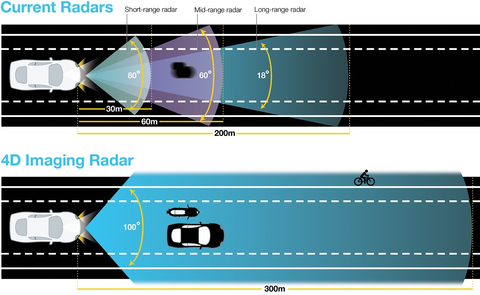
Ultra high-resolution imaging radar is quickly becoming the trailblazing technology for autonomous driving. 4D picture offers real-time obstacle detection that works in all weather and lighting conditions.
We knew this moment would arrive: The autonomous driving industry is facing justified concerns after a few rough months defined by multiple crashes. The conversation surrounding these tragic events is focusing not only on the moral aspect of artificial intelligence, but also on whether the technology behind autonomy is ready.
Those of us in the industry are still hearing that today’s sensors are not mature enough to support tomorrow’s autonomous future. However, 4D imaging radar can make required safety levels achievable.
Achieving high-resolution using radar
The 4D imaging radar is ideal for the automotive industry. It provides a highly detailed image of the environment in a wide field of view. This means it can detect obstacles on the side of the road. It can also detect smaller targets, such as a person or a bike, even if they are somewhat masked by a large object, such as a tree or truck. The imaging radar can determine whether they are moving, in which direction, and provide the vehicle with real-time situational data and alerts.
Additionally, the 4D imaging radar’s ability to detect at the longest range of all sensors gives it the highest likelihood to be the first to identify danger. It can then direct camera and LiDAR sensors to areas of interest, which will considerably increase safety performance as shown in figure 1.

How it differs from current radar on the road
Today, radar already plays a vital role in various safety systems, including adaptive cruise control, blind spot detection, and automated emergency braking. However, with the current radar technology on the market, the functional choice must be made between medium resolution at a limited field of view or low resolution at a wide field of view.
To achieve level 4 and 5 vehicle autonomy, it is essential for automakers to move to the next level of sensing technology and use high-resolution imaging radar that can sense the environment at a wide 100-degree field of view in high-resolution at 1-degree azimuth and 2 degrees in elevation.
Imaging radars are also able to provide true path planning because they can create a detailed image of the road at a range of more than 300 meters (1,000 feet) and capture the size, location, and velocity data of objects surrounding the car. A special focus is placed on object separation by elevation. This enables the radar to recognize whether the car is facing a stationary object right in front of it and must stop or a bridge that it can safely drive under.
Another important level 4 and 5 autonomous driving differentiating factor is the 4D imaging radar’s ability to filter out false alarms. To provide optimal sensitivity, the radar uses the lowest detection threshold, so some noise is reported. Post processing and tracking are used to filter out random noise, while calibration schemes allow extremely low side lobe levels to be reached.
Why optic sensors offer a limited solution
It is common to hear about camera and LiDAR use in the autonomous vehicle sensor suite. And yes, optic sensors certainly are required. However, autonomous vehicles will be not able to reach the required safety performance levels without 4D imaging radar for several reasons, including:
- It provides the highest reliability in various weather and environment conditions, including fog, heavy rain, pitch darkness, and air pollution.
- It detects obstacles at the longest range of more than 300 meters, as required by the automotive industry.
- It measures doppler (radial velocity) in every frame.
Moving out of PoC phases and into mass production
The autonomous driving industry today is still at a proof-of-concept phase. It relies on sensors that may not operate 100 percent of the time. High-resolution imaging radar is the only sensor that always performs at required levels. It also dramatically reduces processing power and server needs. High-quality radar post processing would resolve the current prototypes’ main problem - power consumption - by pointing camera and LiDAR only at areas of interest.
Last, but not least, the mass production cost of the autonomous sensor suite will need to cost less than $1,000. Some of today’s vehicles being tested use components and systems costing a hundred times this price. Since the imaging radar can achieve level 3 and higher without the need for more than one LiDAR unit per vehicle for redundancy, or possibly no LiDAR at all, it can help manufacturers reach cost reduction targets.
The development of autonomous vehicles has reached a crossroad. Upon recent concerns, the advanced mobility industry needs to revisit the role of the high-resolution imaging radar as an indispensable element in the autonomous sensor suite. We look forward to seeing autonomous vehicles back on the road, taking us a step forward towards the future of personal transportation.
About the author
Kobi Marenko is the Co-founder and CEO of Arbe Robotics, a startup company pioneering the use of imaging radar to build a full 4D real-time mapping platform for autonomous vehicles. Marenko is a seasoned entrepreneur, who co-founded and managed several successful media and mobile companies.
Contact: [email protected]
Phone: 1-408-660-7854